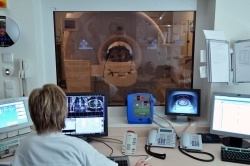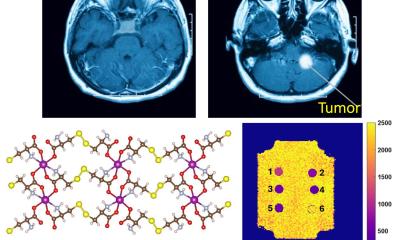Predicting atrial fibrillation with MRI
University of Utah researchers have found that delayed-enhancement magnetic resonance imaging (DE-MRI) holds promise for predicting treatment outcomes and measuring disease progression for patients with atrial fibrillation (AF), a little known heart rhythm disorder that affects more than 3.5 million Americans and causes more than 66,000 deaths a year. Their latest study on a novel application of this technology for AF appears in the April 7 issue of the journal Circulation.

AF is a misfiring of the electrical signals of the heart, which causes rapid and/or irregular heartbeats and is associated with fibrosis (scar tissue) in the left atrium. Although DE-MRI is an established method for visualizing tissue damage in cardiac disease processes, the study assessed its use in a protocol developed to detect fibrosis in AF patients before they underwent radiofrequency (RF) ablation. This procedure involves the use of catheters that emit mild, painless radiofrequency energy to destroy carefully selected heart muscle cells to stop them from conducting extra electrical impulses.
In this study, the University of Utah colleagues developed a protocol using DE-CMRI to create 3-D images of the left atrium before RF ablation, which were processed and analyzed with custom software tools and computer algorithms to calculate the extent of left atrium wall injury. Patients were then assessed at least six months after the procedure, and the researchers found that only 14 percent classified as having minimal fibrosis had suffered AF recurrence compared to 75 percent recurrence for the group that had extensive scar tissue damage.
"Our results indicate that DE-MRI provides a noninvasive means of assessing left atrial myocardial tissue in patients suffering from AF, and that those who do have tissue damage may be at greater risk of suffering AF recurrence after treatment with RF ablation," said lead author Nassir F. Marrouche, M.D., assistant professor of internal medicine in the University of Utah School of Medicine and director of the Atrial Fibrillation Program. "Our findings also present a disease progression model that supports the importance of early intervention."
In addition to its noninvasive nature, DE-MRI offers other advantages over commonly used invasive electroanatomic mapping studies to assess tissue health. For example, while other such diagnostic mapping studies have been associated with a high degree of spatial error, three-dimensional DE-MRI provides information on both the anatomy and the location of pathology without spatial distortion. Marrouche and his colleagues also have developed methods of processing the MRI images in order to visualize the entire volume of left atrium wall injury in 3-D.
"Until now, there has not been an accurate, non-invasive way to assess left atrium scar formation, which studies show is linked to AF disease severity," said Marrouche. "If substantiated, our DE-MRI visualization technique and analysis would provide guidance in determining appropriate candidates for AF catheter ablation as well as in identifying the heart muscle cells that need to be destroyed."
Last fall, the University of Utah Atrial Fibrillation program became the first in the world to be able to ablate using a catheter custom-made to be compatible with MRI. Next month, University Health Care will open a new multimillion dollar clinical and research lab, which will be the first in North America to provide real-time DE-MRI for treating patients with AF.
Source: University of Utah Health Sciences
pic: Elisabeth-Krankenhaus, Essen, Germany
15.04.2009











